Related resources
Bushlarks, Skylarks, & Crested Larks
Identifying Indian and Singing Bushlarks
Larks of Telangana (PDF)
By Ramit Singal
Few birds are as confusing to the beginning birder as Pipits and Larks. The first step towards identifying the species within the two families is to be able to tell between a pipit and a lark. Here is a short guide to telling apart these confusing ground-dwelling birds.
Morphology
Pipits and larks are generally confused with each other because they can look very similar in plumage. Both are usually brown, variably streaked both above and on the breast and generally have some pattern on the face.
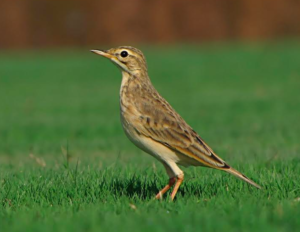
Paddyfield Pipit – note the streaking on the back and on the breast, a clean facial pattern © Ramit Singal

Indian Bushlark – plumage wise, similar to above Pipit with streaking on upperparts and on the breast, relatively well defined facial pattern © Albin Jacob (See in checklist)
However, some pipits may also be relatively plain brown – and correspondingly, some larks may appear quite unlike their congeners and look quite plain as well!
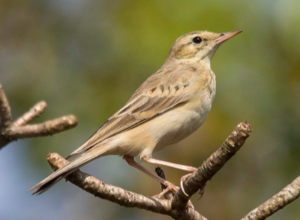
Tawny Pipit – pale, clean breast and upperparts, overall relatively non-descript with not many markings © Pronoy Baidya (see in checklist)
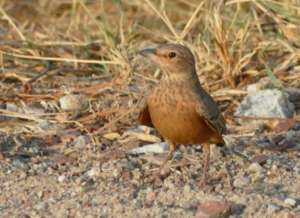
Rufous-tailed Lark – a very different lark from the rest, relatively much plainer and appears quite rufous © Noah Strycker (see in checklist)
Structure
The best way to visually differentiate larks from pipits is to note the structure of the bird. The key differences are highlighted in the following table:
| Pipits | Larks | |
|---|---|---|
| Build | Slimmer, lighter | Dumpier, heavy-looking |
| Bill | Slender | Heavy, thicker (variable) |
| Wings | Narrower | Rounder/broader |
| Tail | Longer | Shorter |
| Nostrils | Fully exposed | Partially exposed (variable) |
| Crest | None | Some show a crest |
Note: All features may not be true for all species, but all pipit or lark species will show at least 3-4 features respectively.
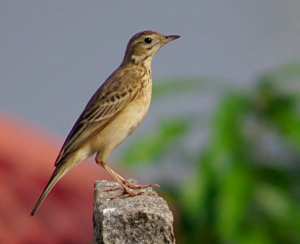
Blyth’s Pipit. Note the overall lighter build, slender beak, exposed nostrils, medium-length tail © Ramit Singal
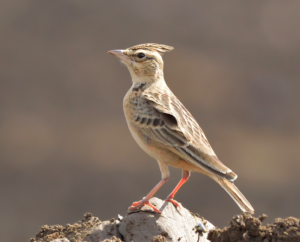
Sykes’s (Tawny) Lark. Note the heavy bill, dumpier looking structure, presence of crest, partially exposed nostril © Vaidehi Gunjal (see in checklist)
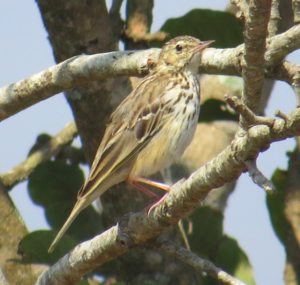
Tree Pipit. Note the lean build, slender bill, exposed nostrils © Syed Muzamil (See in checklist)
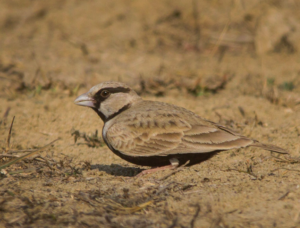
Ashy-crowned Sparrow-lark. Note the bulky structure, heavy bill, short tail, unexposed nostrils, crouched stance © Prashant Kumar (see in checklist)
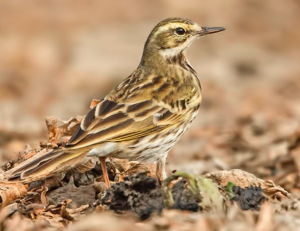
Rosy Pipit. Note the longer tail, slim beak, slender structure, upright looking stance, exposed nostrils © Pranjal J Saikia
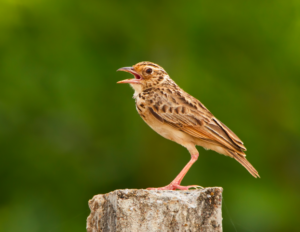
Jerdon’s Bushlark. Note the bulky structure, thick bill, short tail © Vinoba Anand (see in checklist)
Behaviour
Pipits are active feeders, seen moving around and standing upright often.
Larks, on the other hand, are relatively slower and usually appear to have a crouching stance.
(Note: This is indicative of the pipit’s more insectivorous diet, and the lark’s dietary preference for plant material)
Here are a few videos to illustrate these differences in behaviour:
Paddyfield Pipit – note its active behaviour and movements on the ground
https://www.youtube.com/watch?v=ks99W5E00Jc?rel=0
Greater Short-toed Lark – winter migrants to India, seen here scouring the ground for seeds/bulbs/other plant material.
https://youtube.com/watch?v=dcq8mXx-SjY%3Frel%3D0
Malabar Lark – filmed while it was searching for plant material to feed upon
https://www.youtube.com/watch?v=chGP5ddbc6A?rel=0
Vocalization
Calls of pipits and larks can be very similar. However most lark songs are more complex, longer than those of the pipits and may even include mimicry!
To illustrate these differences:
- Across most parts of the country, this Paddyfield Pipit song is often heard in spring and summer.
- The Oriental Skylark song is a remarkable mix of various complex notes and mimicry.
Summary
These guidelines should help you with the first step in tackling larks and pipits. The next step is to distinguish between the different species of larks and pipits. That is a more difficult topic and will be covered in future articles!
Header Image: Paddyfield Pipit Anthus rufulus © Subhadra Devi/ Macaulay Library


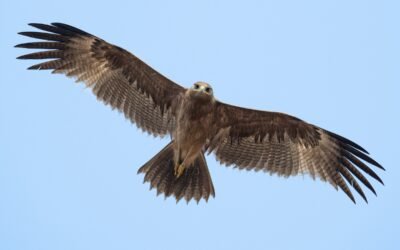
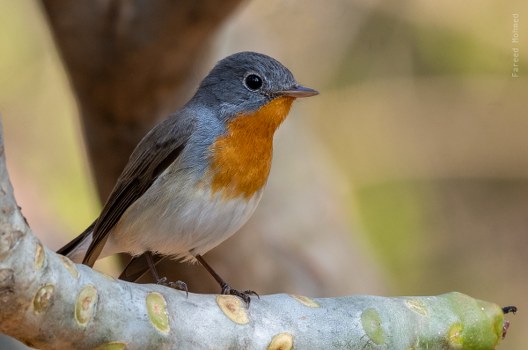
Very helpful
Highly useful. Thank you so much.
Pilots often wag/pump their tails.
Larks make beautiful aerial displays with songs.
Worth reading.. It will help me a lot…
Thanks a lot.. great help in deed.
Thank you for the information..
very helpful
Thank you so much for sharing really helpful
Pipit
Worthful.
Thanks for showing the difference in such a simple way. I love the chart and the videos help in understanding
Excellent learning material. Congrats.
Shaju Thomas
Very informative! Specially the tabulation of major differences…
some serious observations need to be made for larks and pipits in most places. ill represented
Very comprehensive and useful!
Nicely desdribe
Thanks for this information. A useful guide
Useful and
Simple description of both species
Indeed, a wonderful study. Will help many birders
I have never had difficulty in distinguishing between pipits and larks, the erect stance and calls of larks alone being sufficient; it is between the pipits that there is always a problem. Thanks for the notes
Thank you. We have a pipit series coming up in the not-too-distant future!
Thank you very much. Very Helpful..
Thank you for the information..it’s really very helpful.
Good one
Thank you, this was so helpful
Striking differences exposed and very useful.
Very informative and useful. It would be better if video links were clickable.
Can i post a picture?
If you have a bird that needs to be identified, there is a Facebook Group called Ask ID for Birds. You could post your bird photo there and get the answers.
Ver helpful, thanks